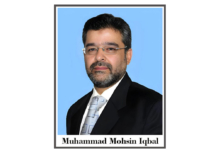I am often called to different conferences to speak on serious issues. Next month, I am due at a conference, where I will speak on education-related problems. I read an article in an online Pakistani paper and found these observations interesting.
Although the country’s educational system has had flaws ever since independence, the degradation has become more serious and visible during the past 50 years. The majority of the population’s educational needs were being met by the public school system up until the 1970s, which was doing a pretty good job of it. All that was needed was to make sure the system expanded and grew to meet the demands of the rapidly expanding population and improve education’s accessibility, particularly at the primary and secondary levels.
The effects are visible not just in dropping performance metrics, but also in the country losing ground to other competitors on a global scale. While Pakistan’s governance system has faced several challenges, the most challenging one is the educational challenge, which is likely the core cause of increasing inefficiency as well as worsening maladies in society.
The rate of enrollment of students for formal schooling remains low. Alarmingly, according to a report of the National Commission on the Rights of Child released in December 2022, an estimated 22.8 million children between the ages of 5 and 16 years (almost ten percent of the country’s total population) are out of school in Pakistan. This makes Pakistan a country with the second highest number of children outside schools and 44 percent of these out-of-school children are engaged in labour or begging.
Apart from a sizable number of children not going to or dropping out of school, Pakistan has not been able to achieve uniformity in its education system and curricula. Public and private sector education is common in the world. But it’s a universal practice in successful educational systems that the state takes care of primary and most of the secondary schooling, while at higher or tertiary education, a combination of public and private universities and degree-awarding institutions are available to accommodate the students.
Three completely different streams of education, however, are operating in Pakistan at the elementary school level with the government’s blessing, and they are public sector schools (limited enrollment and capacity), private sector schools adhering to their norms, disciplines, and price structures (primarily serving the elite and upper-middle-class strata), and (iii) madrassas offering instruction following their Islamic fiqh (version). More startlingly, only 56 per cent of Pakistani students are served by public sector educational institutions, while 44 per cent of students must be accommodated by 38 per cent of private institutions.
Pakistan is going through a challenging period marked by political unpredictability and a severe economic catastrophe. Hopefully, the upcoming national and provincial elections will offer a solution to the current political gridlock. The Parliament and the executive should start making significant changes to Pakistan’s educational system as soon as this phase is ended. Pakistan also struggles to meet the demand for white- and blue-collar labour in North America, Europe, the Middle East, and Japan due to educational deficiencies. Furthermore, one of the major impediments to the entry of FDI by multinationals into Pakistan is a shortage of appropriately skilled labour.
The changes are long overdue. All residents should consistently receive an education. It’s time to return to a single curriculum that satisfies all national criteria and a standard indigenous examination system for both the public and private sectors. The mainstreaming and integration of madrasa education into the national system cannot be postponed indefinitely.
The tertiary sector, or university education, in Pakistan has underperformed due to serious problems in primary and secondary education. There are 1.576 million students enrolled in 186 colleges and universities nationwide, or just 0.68 per cent of the entire population. The backbone of Pakistan’s industrialised and commercial sectors, technical and vocational training institutes, are similarly in low supply.
The education system in Pakistan has serious inequalities that are preventing social and economic change. Due to the region’s other developing nations like China, India, Malaysia, and Bangladesh not producing enough educated and skilled middle class and labour, the much-needed transition from an agriculture-based nation to a modern industrial economy is still wrought with obstacles.
University and higher education reforms should aim to groom the next generation following national development and economic needs. It would be impossible to create industrial and commercial success without having a skilled and trained labour force, hence a particular initiative is required to establish a statewide network of vocational training colleges.
Above all, transitioning Pakistan’s increasing population into a productive human resource will be impossible without a large rise in education spending for the country’s future. And the time for implementing these critical actions is limited.







